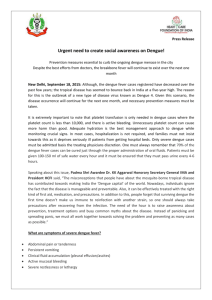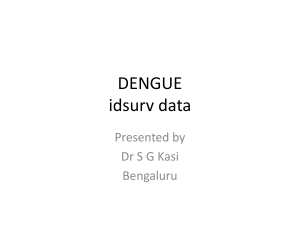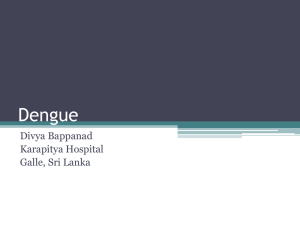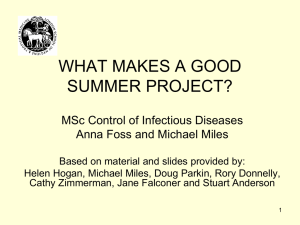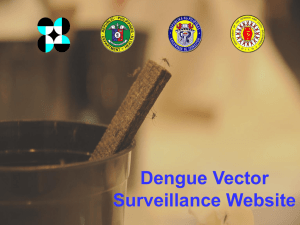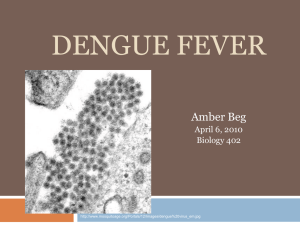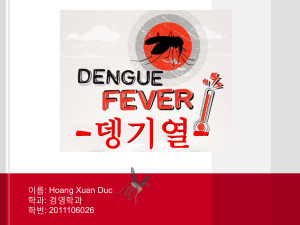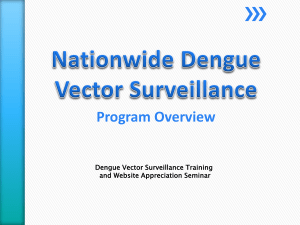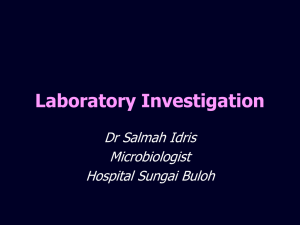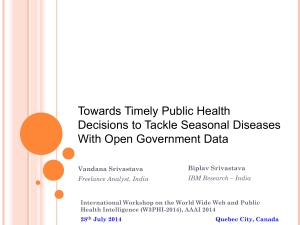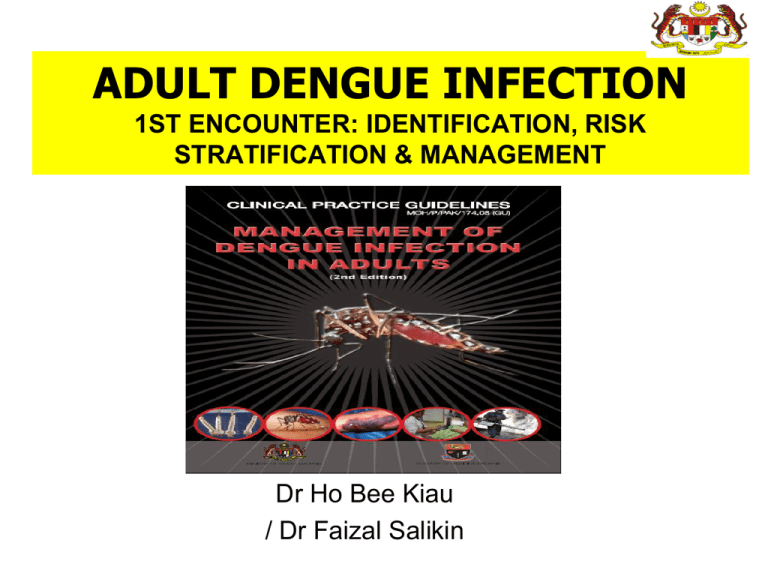
ADULT DENGUE INFECTION
1ST ENCOUNTER: IDENTIFICATION, RISK
STRATIFICATION & MANAGEMENT
Dr Ho Bee Kiau
/ Dr Faizal Salikin
OBJECTIVES:
TO IDENTIFY AND MANAGE DENGUE
INFECTION AT 1ST ENCOUNTER
• Outpatient management & monitoring
– Stepwise approach
• Diagnostic challenges
• Triaging at ED & OPD
• Indication for referrals / admission
OUTPATIENT MANAGEMENT &
MONITORING
• Symptomatic and supportive
• Should be assessed with stepwise
approach
• Focus of management - 3 phases of the
clinical course
• Frequent monitoring to recognise plasma
leakage and shock early
• Dengue monitoring record as an
outpatient monitoring tool
• Refer if no immediate HCT facilities
STEP 1 - OVERALL ASSESSMENT
1. History
• Other important
• Onset of fever
history:
• Oral intake
a. Neighbourhood
• Diarrhoea
history of dengue
• Urine output
b. Travelling/ jungle
• Assess for warning trekking/ swimming in
signs
waterfall
d. Recent unprotected
sex or IVDU
e. Co-morbidities
WARNING SIGNS
• Abdominal pain or tenderness
• Persistent vomiting
• Clinical fluid accumulation (pleural effusion,
ascites)
• Mucosal bleed
• Restlessness or lethargy
• Liver enlargement > 2 cm
• Laboratory : Increase in HCT with rapid
decrease in platelet
STEP 1 - OVERALL ASSESSMENT
2. Physical examination
i. Assess mental state & GCS
ii. Assess hydration
iii. Assess haemodynamic
• Skin colour
• Cold/ warm extremities
• Capillary filling time (normal < 2 sec)
• Pulse rate & pulse volume
• BP & pulse pressure
STEP 1 - OVERALL ASSESSMENT
2. Physical examination
iv. Look out for tachypnoea/
acidotic breathing/ pleural
effusion
v. Check for abdominal
tenderness/ hepatomegaly/
ascites
vi.Examine for bleeding
manifestation
vii.Tourniquet test (repeat
if previously negative)
TOURNIQUET TEST
How to perform?
• Inflate the BP cuff on the
upper arm to a point
midway between the SBP
& DBP for 5 min.
• A positive test : ≥20
petechiae per 6.25 cm2
(1 inch2)
Note:
• Helpful in the early febrile
phase (< 3 days) esp.
when the platelet count is
still normal
STEP 1 - OVERALL ASSESSMENT
3. Investigation
i. Serial FBC and HCT
ii. Dengue serology
•Leucopaenia followed by progressive
thrombocytopaenia (dengue infection)
•Rising HCT accompanying progressive
thrombocytopaenia (DHF)
•In the absence of a baseline HCT level, a
HCT value of >40% in female adults and
>46% in male adults should raise the
suspicion of plasma leakage
STEP 2: DIAGNOSIS, DISEASE STAGING
AND SEVERITY ASSESSMENT
a) Dengue diagnosis (provisional)
b) The phase of dengue illness
(febrile/critical/recovery)
c) The hydration and haemodynamic status
(in shock or not)
d) If admission indicated (triage)
DIAGNOSTIC CHALLENGES
• Clinical features of dengue infection are
rather non-specific and can mimic many
other diseases
• A high index of suspicion and appropriate
history taking (e.g. dengue hotspots) are
useful
• May have co-infection
• Syndromic approach - helpful
DIFFERENTIAL DIAGNOSES
DURING FEBRILE PHASE
DIFFERENTIAL DIAGNOSES
DURING CRITICAL PHASE
TRIAGING AT ED & OPD
• To determine whether urgent attention required
• Look out for warning signs of shock
• Triage Checklist
1. History of fever
2. Abdominal Pain
3. Vomiting
4. Dizziness/ fainting
5. Bleeding
• Vital parameters to be taken:
– Mental state, BP, pulse, temp., cold or warm
peripheries
STEP 3: PLAN OF MANAGEMENT
a) Notify the district health office
via phone followed by disease
notification form
b) To determine whether the
patient requires admission
IF ADMISSION NOT INDICATED
WHAT NEXT?
• Daily or more frequent f/u from day 3
of illness until afebrile for at least 24–
48 hours
• Provide Dengue monitoring record
& Home Care Advice Leaflet
• Advise patient to return to hospital as
soon as the warning signs arise
HOME CARE ADVICE LEAFLET
• Encourage adequate intake of fluids
– eg: fruit juice/barley water/isotonic
drink/milk
• Ensure patient pass urine every 4-6 hours
• PCM/ tepid sponging for fever
• Avoid NSAIDs !
HOME CARE ADVICE LEAFLET FOR DENGUE PATIENTS
CRITERIA FOR HOSPITAL
REFERRAL / ADMISSION
Symptoms:
1. Warning signs
2. Bleeding
manifestations
3. Inability to tolerate oral
fluids
4. Reduced urine output
5. Seizure
Signs:
1. Dehydration
2. Shock
3. Bleeding
4. Any organ
failure
CONSIDER EARLY ADMISSION
• Co-morbidity e.g. DM, HPT, IHD,
Coagulopathies, Morbid Obesity, Renal
failure, Chronic Liver disease, COPD
• Elderly > 65
• Pregnancy
• Social factors: living far, living alone etc
Lab. criteria
• Rising HCT with reducing platelet count
REFERRAL FROM HOSP. WITHOUT
SPECIALIST TO HOSP. WITH SPECIALISTS
• Early consultation with the nearest
physician for ALL DHF or DF with organ
dysfunction/ bleeding
Prerequisites for transfer
• Optimise the patient’s condition before &
during transfer
• The ED/ Medical Department of the
receiving hospital must be informed
• Adequate information to be sent together
e.g. fluid chart, monitoring chart &
investigation results
COMMON ERRORS AT
OPD & A&E DEPARTMENT (1)
• Failure to recognise dengue infection
in a febrile patient
• In febrile phase, always have high index
of suspicion in
– febrile patients coming from dengue
areas
– patients with symptoms of dengue
– patients with positive Hess’s test
Common Errors at
OPD & A&E Department (2)
• Failure to recognise dengue shock in
an afebrile patient
• In the afebrile patient, always have high
index of suspicion for
– Nausea, vomiting, abdominal pain &
warning signs
– Manifestations of compensated and
decompensated shock
– Changing HCT (rather than platelet
count)

